|
Thurs., Aug. 9
1:00 p.m.
Research Techniques Seminar - WH-8XO, Hornet's Nest
Speaker: A. Penzo, INFN Trieste
Title: Compensating Hadron Calorimetry
THERE WILL BE NO ILC ALCPG PHYSICS AND DETECTOR R&D
SEMINAR THIS WEEK
2:30 p.m.
Theoretical Physics Seminar - Curia II
Speaker: J. Zupan, Institut Jozef Stefan
Title: Probing Minimal Flavor Violation at the LHC
3:30 p.m.
DIRECTOR'S COFFEE BREAK - 2nd Flr X-Over
THERE WILL BE NO ACCELERATOR PHYSICS AND TECHNOLOGY SEMINAR TODAY
Fri., August 10
3:00 p.m.
DIRECTOR'S COFFEE BREAK - 2nd Flr X-Over (NOTE TIME)
3:30 p.m.
Joint Experimental-Theoretical Physics Seminar - One West (NOTE TIME)
Speakers: M. Neubauer (CDF), University of Illinois, Urbana/Champaign
John Hobbs (DZero), State University of New York, Stony Brook
Title: New Results for Lepton-Photon 2007 from CDF and DZero
8:00 p.m.
Fermilab International Film Society - Auditorium
Tickets: Adults $5
Title: Die Blechtrommel (The Tim Drum)
Click here for NALCAL,
a weekly calendar with links to additional information. |
Thursday, August 9
- Southwestern Chicken Tortilla
- Philly Style Cheese Steak
- *Garlic Herb Roasted Pork
- Tomato Basil Chicken Parmesan
- Southwestern Turkey Wrap
- Assorted Slice Pizza
- *Marinated Grilled Chicken Caesar Salads
*Carb Restricted Alternative
Wilson Hall Cafe Menu |
|
Thursday, August 9
Dinner
Closed
Wednesday, August 15
Lunch
- Chinese Chicken
- Mushroom Lettuce Cups
- Grilled Bananas w/Rum Sauce
Chez Leon Menu
Call x4598 to make your reservation. |
|
|
Steering Group submits
draft report to director
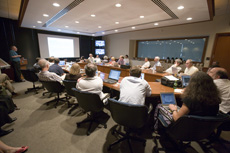
Members of the Steering Group met at Fermilab throughout the summer.
On Tuesday, the Fermilab Steering Group submitted a draft report on Fermilab's plan for the future to Director Pier Oddone. In late March, Oddone had asked Deputy Director Young-Kee Kim to chair the Steering Group (see Director's Corner, April 17, 2007). The 14 members of the Steering Group held meetings throughout the spring, seeking input from the Fermilab and U.S. particle physics community.
This week, the Fermilab Accelerator Advisory Committee is reviewing the accelerator component of the draft report, and on August 24, at noon, Kim will give a presentation in Ramsey Auditorium. The Steering Group plans to issue the final report in about a month. Kim will present the final report at the meeting of the Particle Physics Project Prioritization Panel (P5) on September 24-25. More information on the Steering Group and the report is here.
|
Hands-on science offers students realistic experiences
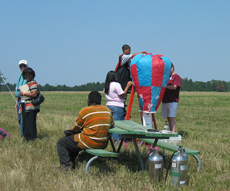
Students from Fermilab's TARGET program put the finishing touches on a hot air balloon as their teachers look on.
Patches of yellow and green dotted a cloudless blue sky last Friday afternoon as 19 high school students launched hand-made hot air balloons into the wide open fields off of Eola Road.
The launch, designed to demonstrate the effects of volume on buoyancy, was the final project of the Fermilab and TARGET Science and Engineering Program, a six-week summer experience for minority students from 16 Chicagoland area high schools.
"Our goal with TARGET is to expose talented students to the possibilities of careers in technical disciplines and to encourage them to prepare for their futures in the exciting and challenging fields of science and engineering," said Equal Opportunity Office Manager Dianne Engram.
During their stay, students gained valuable work experience by observing the laboratory's infrastructure and performing administrative and entry-level support tasks. They spent most of their time working on classroom-based experiments. Hands-on problem-solving applications such as the balloon launch highlighted the ideas learned in the classroom. "We have all different responsibilities," said Floyd McGee, 17, a participant from Rich South High School. "But the best part is definitely doing the experiments. We've learned about drift airplanes, camera filters and pin-hole photography."
Other popular projects included radio assembly, soldering and parachute building. Each student presented the methodology and results of a designated project at the closing program last Friday.
-- Lauren Younis
|
Picture this: visualization as a tool for data analysis
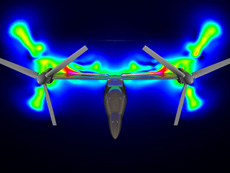
This is one image from a 3000-frame visualization showing air movement around Osprey rotors. It is one of visualization expert Kelly Gaither's all-time favorites.
Image courtesy of Kelly Gaither
Transformers are no longer just toys from the 1980s.
Bell-Boeing Ospreys are a real-life example of a transforming machine; they can begin flight as a helicopter, with rotors on top, and change mid-flight to operate like an aeroplane, with rotors in front.
A few years ago, however, after two Osprey accidents, the United States government grounded the fleet.
"The planes were having problems during the rotor transition," says Kelly Gaither. "Our job was to figure out why."
Gaither is a visualization expert at the Texas Advanced Computing Center. She and her team simulated, visualized and created a 3000-frame movie to show air movement around the Osprey during transition.
Read More
|
|
|
How to detect the undetectable
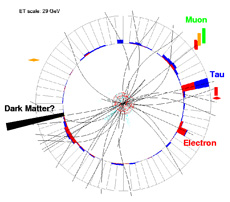
This figure shows an event display of a Chargino/Neutralino candidate in the final state with one electron, one muon and one tau. The black bar on the left indicates the missing energy and is the signature for particles that escaped detection, such as dark matter.
Everybody has experienced the difficulty of trying to find something in a dark room. Imagine how much more difficult searching becomes if you cannot see the things you are searching for when the lights are on. Dark matter, which makes up 25 percent of our universe, poses exactly this challenge. We know very litte about the true nature of dark matter, but theorists have come up with some ideas. Supersymmetry (SUSY) is currently the most favored theory, and if SUSY is realized in nature, physicists at the Tevatron might have a chance to find dark matter: even if it doesn't appear in their detectors.
SUSY extends existing theories by introducing "super-partners" for all known particles: each fermion receives a boson partner and vice versa. However, because we have not seen any super-partners, we know they must be rather massive compared to normal matter. These super-partners are very hard to find amidst the huge backgrounds of physics processes at the Tevatron collider. They would be produced at a very low rate if they existed. Complicating the picture is the lightest SUSY particle (the dark matter candidate), which would escape a detector without a trace. It could be seen only indirectly because it carries away energy and momentum as it escapes, leaving behind an "imbalanced" event.
DZero physicists have searched for SUSY particles in the final states of three leptons (e.g., electrons, muons, taus) and large missing energy. This signature is characteristic of the so-called Charginos and Neutralinos, which are super-partners of the Standard Model bosons. The tri-lepton production turns out to be very clean, and the DZero analyzers are able to maximize their efficiency by requiring not three identified leptons, but two leptons and an isolated track. In up to 1.7 inverse femtobarns of data no excess of events consistent with SUSY production was observed. This allows the DZero analyzers to set upper limits on the production cross section for Charginos and Neutralinos. Although they found no SUSY particles, DZero scientists are not resting as new data pours in from the Tevatron. After all, seeing nothing might shed light on 25 percent of the darkness in the universe!
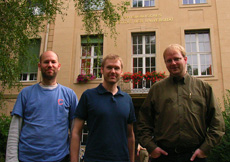
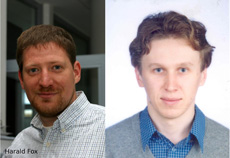 |
|
Marc Hohlfeld, Olav Mundal, Volker Buescher (Bonn University), Harald Fox (Lancaster University), and Maxim Titov (CEA Saclay, DAPNIA) all made primary contributions to this analysis.

Al Ito (left), Penny Kasper (center), Huishun Mao (right), and Norik Kahalatyan (not pictured) work to maintain the central muon detector system at DZero. The central muon group ensures high efficiency muon detection which in turn fuels analyses like this one.
Result of the Week Archive
|
From Parade Magazine
August 5, 2007
Why America Needs to Explore Space
While China has announced an initiative to land humans on the moon by 2020, experts say that the limited funding of NASA will make it difficult for the U.S. to return to the moon by then. We asked the nationally renowned astrophysicist Neil deGrasse Tyson what this might mean for our nation.
Read more
|
|
FRA Scholarship Update
FRA is pleased to announce its scholarship and tuition remission programs for various Illinois-based Universities. Employee Relations has placed the information on one website for your convenience. Please visit the FRA Scholarship homepage for links and contact information for each program.
Wisconsin Dells Discount Book
The final day to purchase the Wisconsin Dells Coupon book is August 17. Books are still available in the Recreation Office and the discounts are good until April 1, 2008. The cost of the book is $20.
Additional Activities |
|